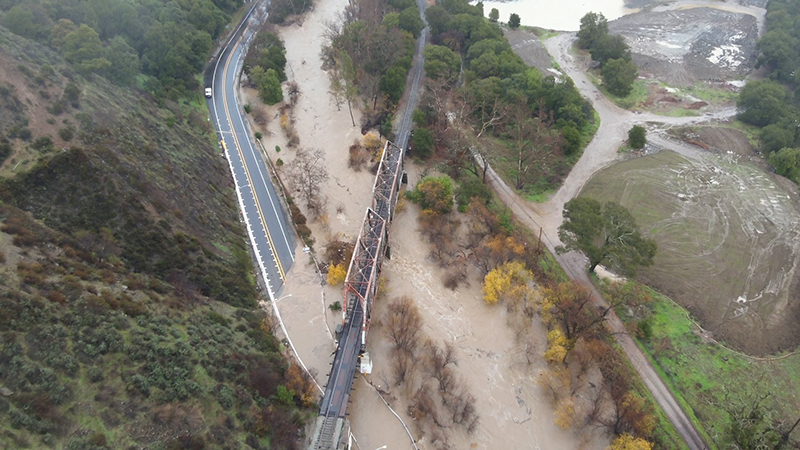
Drone and camera makers have greatly improved the visible light (optical) and thermal imaging cameras being carried by unmanned aerial vehicles (UAVs), ramping up their clarity, zoom ability, and thermal imaging palettes.
With those improvements, fire departments, their pilots, and incident commanders (ICs) are getting a better look at situations on the ground that they might otherwise not be able to see.
The Fire Department of New York (FDNY) UAV unit operates under the Robotics section in Special Operations, which is housed with Rescue Battalion 1 in Special Operations Headquarters on Roosevelt Island in Queens. Andrew Scharf, a firefighter and pilot with the drone unit, says the FDNY operates its drones out of Command Tactical 1, a GMC 3500 with a quad cab and utility body. “Its staff is one pilot, a fire officer, a visual observer, and a data specialist, all FDNY firefighters,” Scharf says. “Command Tactical 1 carries between six and eight aircraft at any time.”
- Fire Department Drone Use Grows as Technology Improves
- Drones Becoming Popular Tools Used by Police, Fire Departments in Eastern IA
- Phoenix (AZ) Fire Department Launches Drone Program
- Drones Archives
“Our main aircraft now is the DJI Matrice 30T that has a 12-megapixel wide-angle camera that’s very good for flying and positioning the aircraft,” Scharf says. “It’s zoom camera is 48 megapixels and starts at 2x zoom and goes to 150x zoom. The first 20x is optical zoom, then the rest is digital. The unit’s thermal camera features 640-pixel resolution, and there’s a thermal super resolution model that can double the pixels to 1,280 pixels, which allows us to pick up really small hot spots.”
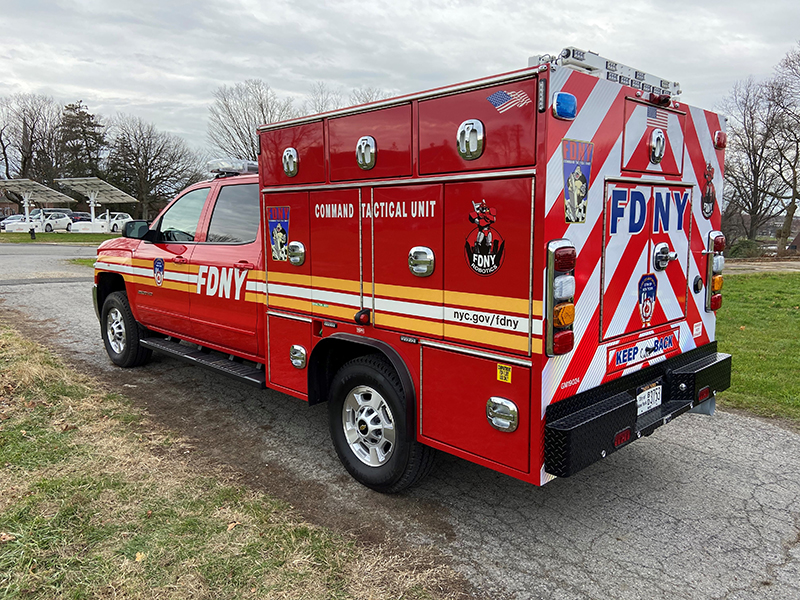
1 The FDNY operates its drones out of Command Tactical 1, a CC 3500 with a quad cab and utility body that carries between six and eight UAVs at any time. (Photos 1-3 courtesy of Fire Department of New York.)
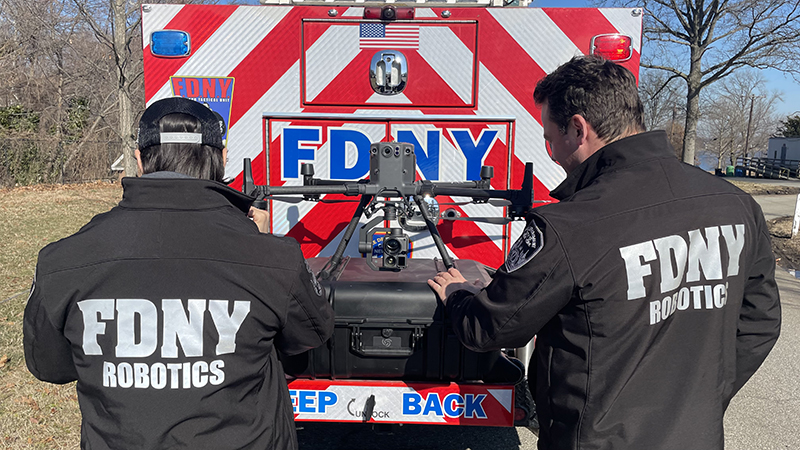
2 FDNY firefighters prepare a DJI Matrice 300 UAV for flight.

3 The FDNY’s Robotics unit flies a UAV on a fire scene to give the IC a look at the situation from above.
The FDNY also flies the DJI Matrice 300, the DJI Mini, and the DJI Mavic 2 Enterprise Dual drones. “Because the Matrice 300 is a larger drone, it performs very well in wind and rain,” Scharf says, “but the M30 holds its own in windy conditions too. The M300 has a large spotlight on one of its gimbals that allows us to light up an entire rooftop, and it’s great for searches too. With the M30’s infrared, we are able to take off, scan all four sides of the building, then usually position in the rear of the building to give the chief his hardest-to-get view.”
Scharf points out that the thermal sensors on all the DJI aircraft that the FDNY flies have isotherms that enable operators to narrow down the range of what they are viewing by raising the low threshold and lowering the high threshold for a close-in look at something. “There’s also a choice of color palettes, where some of them make hotter things stand out more, while others make smaller variations in temperature stand out more,” he says.
Fremont (CA) Fire Department Battalion Chief Jeff Kleven says Fremont has six airframes in its drone air fleet, including DJI Matrice 30, Matrice 210, Phantom units; an Autel EVO II; and an Aeryon Sky Ranger. “If we need a quick look, we’ll put up a Mavic first because we can get it up so quickly while someone else is setting up the larger Matrice 30,” Kleven says. The Mavic has a 20-megapixel optical camera, a 12-megapixel camera with up to 50x zoom, and a 640 x 512-pixel thermal resolution radiometric camera that reads the temperature of each pixel.
Fremont’s Matrice 30 has a wide-angle 12-megapixel camera with up to 200x zoom, a 640 by 512-pixel thermal camera, and a laser rangefinder that can give GPS coordinates of latitude and longitude of where the laser is pointing. “We used the M30 on a two-story Victorian home where we couldn’t locate the fire,” Kleven points out. “When we got the M30 up, it located the fire right away from its heat signature coming from the subfloor in the basement. The owner was doing some plumbing work and had been sweating a copper pipe that morning.”
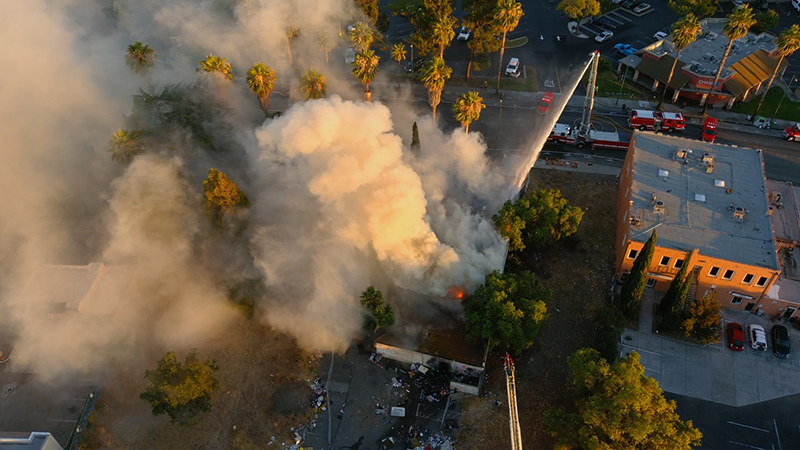
4 The Fremont (CA) Fire Department used a DJI Matrice 30 to give the IC this view of a smoky structure fire. (Photos 4-6 courtesy of Fremont Fire Department.)

5 Fremont’s drone team used one of its UAVs to perform reconnaissance during a flooding event.

6 This thermal imaging view from a Fremont UAV of a nearly fully involved attic space prevented the truck crew from encountering a dangerous situation in accessing the roof.
Kleven adds that the M30 also has a top mount for a combination spotlight and loudspeaker for one-way communication. “The spotlight gimbals can be controlled up and down and can be locked onto what the camera is viewing, which can make the daytime camera useful at night,” he says.
Drones also can provide a measure of safety to firefighters responding to a call, Kleven maintains. “A couple of weeks ago, we got a call for a chimney fire,” he says. “We had the drone look at the roof and found that the fire had spread throughout the entire attic space. A truck company was getting ready to get onto the roof but was called off because the drone warned us to avoid a possible dangerous situation.”
Clint Fey, division chief of Special Operations for the West Metro (CO) Fire Rescue, says his department mainly relies on the DJI Matrice 300 with the H20T sensor for drone work. The aircraft carries a 20-megapixel optical camera with 23x optical and 200x digital zoom, a 640 by 520 pixel thermal camera with radiometrics to pinpoint temperatures, and a laser rangefinder that is functional to 1,500 meters.
“The M300 is a super capable tool that is IP44 weather rated so it can fly in rain, snow, and other inclement weather,” Fey says. “We recently used it on a very deep-seated crawl space fire where it was super smoky and very hard to see. We used it for personal accountability on that scene and also to see the heat waves coming out of various windows.” For a recent attic fire in a town home, Fey says, “the drone identified the exact location of the fire, and when we hit it with water, you could see the fire cool down on the thermal image.”
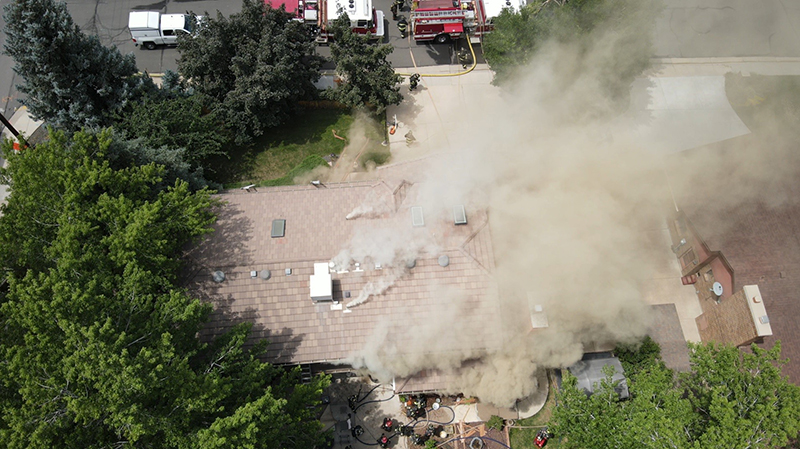
7 The West Metro (CO) Fire Rescue used a DJI Matrice 300 to identify the location of a deep-seated crawl space fire in this home. (Photos 7-9 courtesy of West Metro Fire Rescue.)
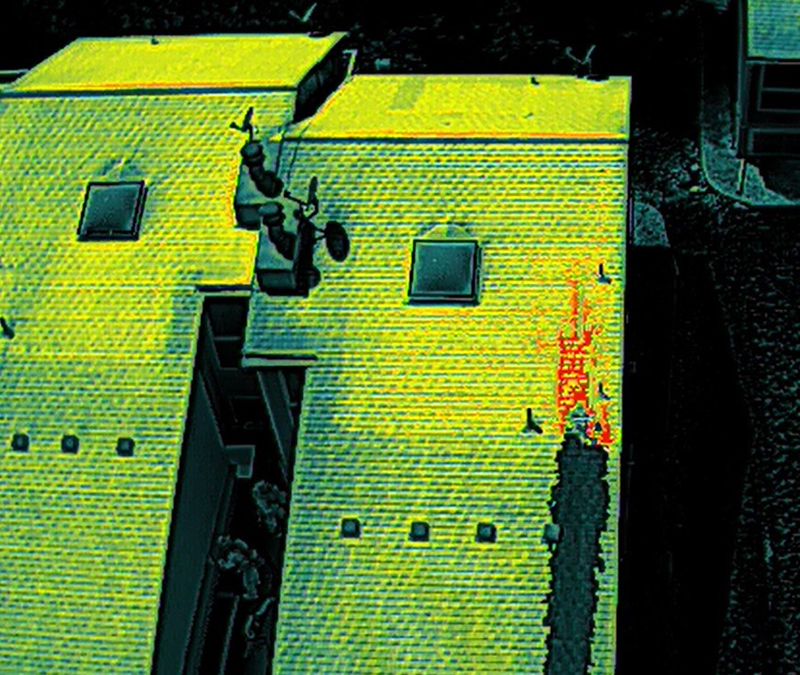
8 This thermal image from a West Metro drone shows the extent of this attic fire prior to crews accessing the space.
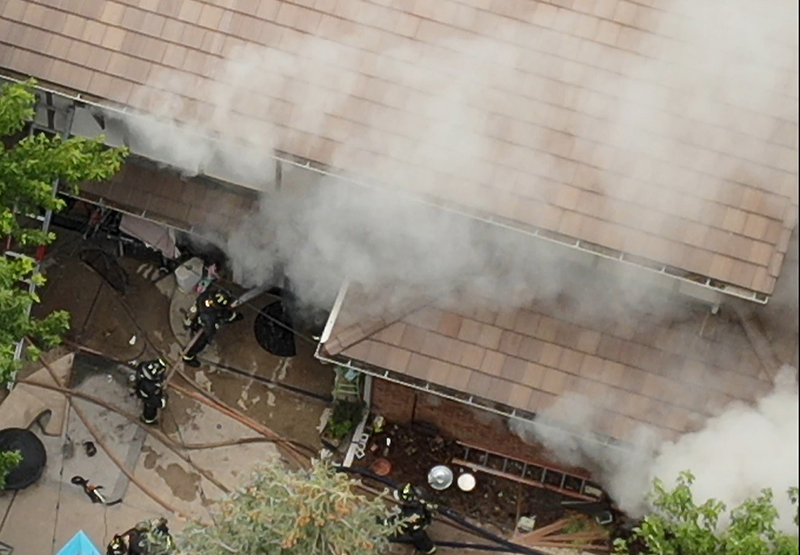
9 Drones have proven very useful in showing ICs the unseen sides of fire structures, as shown in this West Metro drone view of the C side of a house on fire.
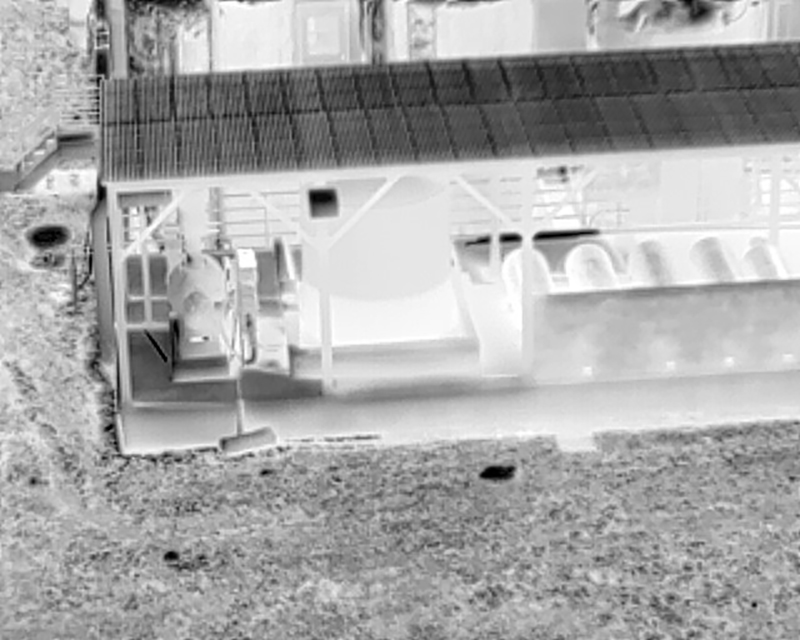
10 A DJI drone thermal image provided the IC with a close look at these tanks during a hazardous materials call. (Photo 10 courtesy of DJI.)
The division chief carries the M300 in a Ford F-150, along with a DJI Mavic Enterprise 2 Advanced, Fey says. “The Mavic is very quick to deploy and can be done with only one operator, where the M300 has a pilot and visual observer. The Mavic also does dual imaging, with a 32x digital zoom optical camera and a 640 by 512-pixel thermal camera,” he adds.
Wayne Baker, DJI’s director of public safety integration, says both the Matrice 30 and Matrice 300 have flown in pretty heavy rains and also are able to fly in cold weather. He says they can be fitted with the Zenmuse H20 wide-angle camera with zoom capabilities, the H20T with a wide-angle and zoom camera as well as a thermal camera, and the H20-10 system with two focal lengths on two thermal cameras to give the unit a better depth of field on a fire.
DJI also offers the Zenmuse P1 45-megapixel camera for very high resolution optical images, useful for damage assessment, mapping, and preincident planning; and the Zenmuse L1, a lidar laser imager with a RGB (red, green, blue) camera that can penetrate through tree canopies and is useful with search and rescue (SAR) teams and wildland firefighters for more accurate looks at terrain and elevation as well as vegetation density.
Jon McBride, global vice president of training and technology for Autel Robotics, says that Autel’s EVO II Enterprise v3 with a dual payload of a 20-megapixel optical camera and a 640 by 512 radiometric thermal camera is Autel’s most popular unit with fire departments right now. He says Autel also makes the slightly larger EVO Max, which is still foldable and portable, with a 640 by 512-pixel radiometric thermal camera and a 48-megapixel visual camera.
Users have the choice of controlling Autel UAVs through its Explore app, an interface between the user and the drone, or through Autel’s Smart Controller, McBride points out, an all-in-one-box unit that has the controller, a 7.9-inch screen, Autel’s Enterprise app, and Android running in the background to control the UAV. “It offers different payloads and drone features, including better obstacle avoidance, millimeter wave radar, and interference troubleshooting for communications,” he says.
Jeb Brown, an engineer at W.S. Darley & Company, says that Darley offers both DJI, Autel, and Parrot UAVs that are being purchased by municipal fire departments. “All of the UAVs have very good optical and thermal cameras, which allow for great situational awareness for fire commanders,” Brown says. He adds that most of the UAVs that Darley sells are the DJI Matrice 30 and Mavic Enterprise Dual models.
Matt Sloane, chief executive officer of Skyfire Consulting, observes that fire service customers are getting more sophisticated as new and improved products are introduced and the drone market matures. “The lower end of 120 pixels for optical and 336 pixels thermal was okay at first, but now 640 pixels is standard for thermal, and we’re even seeing some affordable units in the 720-pixel range,” Sloane says. “Most of the public safety agencies use both optical and thermal cameras on their drones, where they are used in hazardous materials incidents, checking hot spots, and viewing the back side of fire structures—and especially a lot in SAR situations.”
ALAN M. PETRILLO is a Tucson, Arizona-based journalist, the author of three novels and five nonfiction books, and a member of the Fire Apparatus & Emergency Equipment Editorial Advisory Board. He served 22 years with the Verdoy (NY) Fire Department, including in the position of chief.

